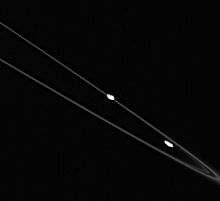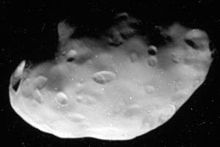Pandora (moon)
| Pandora | |
|---|---|

|
|
| Pandora, captured by the Cassini-Huygens spacecraft on September 5, 2005 | |
| Provisional or systematic name | S / 1980 S 26 |
| Central body | Saturn |
| Properties of the orbit | |
| Major semi-axis | 141,720 ± 10 km |
| Periapsis | 141,125 km |
| Apoapsis | 142,315 km |
| eccentricity | 0.0042 |
| Orbit inclination | 0.050 ± 0.004 ° |
| Orbital time | 0.628504213 d |
| Mean orbital velocity | 16.38 km / s |
| Physical Properties | |
| Albedo | 0.60 |
| Apparent brightness | 16.0 mag |
| Medium diameter | 80.6 ± 4.4 (103 × 80 × 64) km |
| Dimensions | 1.356 ± 0.022 x 10 17 kg |
| surface | ≈ 21,000 km 2 |
| Medium density | 0.49 ± 0.08 g / cm 3 |
| Sidereal rotation | 0.628504213 days |
| Axis inclination | 0.0 ° |
| Acceleration of gravity on the surface | ~ 0.0034 m / s 2 |
| Escape speed | ~ 20.80 (mean) m / s |
| Surface temperature | ≈ −195 ° C (78) K |
| discovery | |
| Explorer | |
| Date of discovery | October 1980 |
| Remarks | F-ring outer shepherd moon |

|
|
| The positions of the inner moons of Saturn in Saturn's ring system, from inside to outside Pan, Atlas, Prometheus, Pandora, Janus & Epimetheus, Mimas, Enceladus, Tethys, Dione and Rhea | |
Pandora (also Saturn XVII ) is internally the sixth and twelfth largest of the 82 known moons of the planet Saturn . As a so-called shepherd's moon, it orbits the planet outside the F-ring of Saturn's rings and stabilizes it together with its partner Prometheus, which is circling within .
The delicate F-ring connects directly to the bright A-ring visible in the telescope, but cannot be observed from Earth.
Discovery story
Pandora was discovered in mid-October 1980 by the astronomers Stewart A. Collins and D. Carlson at the same time as the moon Prometheus when evaluating images from the space probe Voyager 1 , which passed Saturn on November 12, 1980 , before the probe flew by.
On October 31, 1980, the discovery was announced by the International Astronomical Union (IAU); the moon was initially given the provisional designation S / 1980 S 26 . This high numbering resulted from the opinion that Saturn had 27 moons so far, which later turned out to be an exaggeration. Since many of the "newly discovered" moons were already known, the number was reduced to 16, making Pandora the 15th to discover and confirm Saturn's moon . Due to the simultaneous discovery of Prometheus and shortly afterwards the Atlas , the Roman numbering was assigned according to the ascending order of the distances to Saturn; Pandora thereby received the number XVII .
designation
Relatively late, on January 3, 1986 - the same time as Prometheus and the Pluto moon Charon - the moon was then Pandora named after the Greek mythology was created to the people for the fire robbery of Prometheus to punish. She is the first woman in history and was made from clay on the instructions of Zeus of Hephaestus . In order to make it seductive, the gods endow it with many gifts such as beauty, musical talent, dexterity, curiosity and high spirits. Aphrodite also gives her gracious charm, Athena adorns her with flowers and Hermes , from whom she takes her name, gives her an enchanting language. Zeus handed her the " Pandora's box " named after her , which was filled with a special gift by each of the Olympian gods , all but one of which were perishable. Zeus descended to earth with Pandora and presented it as a gift to the titan Epimetheus , who, contrary to an earlier warning, also accepted and married Pandora from his brother Prometheus. Pandora (or her husband Epimetheus) opens the box, and the diseases, plagues, vices and vices contained in it were let loose on the people. Before the only positive gift - hope - can escape from the box, it is closed again. So the world becomes a desolate place until Pandora opens the box again and also lets hope into the world. But the golden age in which mankind was spared work, disease and death is over for good.
Since early Christianity, the story of Pandora has often been viewed as an allegory of the biblical fall into sin . Pandora becomes the seductive Eve and Epimetheus becomes the seductive Adam .
The name is composed of pan for all, total, and doron for gift, present; Traditionally, however, it is translated as “all gifted”.
Track properties
Orbit
Pandora orbits Saturn in a prograde , almost perfectly circular orbit at an average distance of 141,720 km (approx. 2,351 Saturn radii) from its center, i.e. 81,452 km above its cloud ceiling. The orbit eccentricity is 0.0042, the orbit is inclined 0.05 ° to the equator of Saturn , so it is almost exactly in the equatorial plane of the planet. Due to the low eccentricity, the orbit varies in distance to Saturn by only around 1,190 km.
The orbit of the next inner moon Prometheus is on average 2,340 km away from the orbit of Pandora, the distance of the orbit of the next outer moons Epimetheus and Janus is on average 9,690 and 9,740 km respectively.
Pandora orbits Saturn in 15 hours, 5 minutes and 2.8 seconds. This corresponds to a little more than the orbital period of the Uranus moon Cupid . Pandora takes about 23 minutes longer to make one orbit than its inner neighbor Prometheus.
The moon runs around 1,500 km outside of the narrow, faint F-ring discovered by the Pioneer 11 spacecraft in 1979 . It moves in the gap between the F-ring and the Janus / Epimetheus dust ring , discovered in 2006 and about 5,000 km wide , from whose inner boundary Pandora is about 7,300 km away. It acts as an outer shepherd's moon with its gravitation on the F-ring of Saturn and causes deformations in the ring with the inner shepherd's moon Prometheus. Above all, Pandora also has a stabilizing effect on the F-ring; it holds the ring in its narrow form on the outside and Prometheus on the inside, and the union of the attractive forces of these two moons prevents the dust from spreading outwards.
Pandora's orbit appears chaotic ; it is a consequence of four 121: 118 orbital resonances with Prometheus. The most noticeable changes in orbit occur roughly every 6.2 years, when the periapsis of Pandora is in line with the apoapsis of Prometheus and the two bodies are separated by a distance of about 1,400 km. Pandora itself perturbs the orbit of its inner neighbor Atlas to some extent, but far less than the inner shepherd's moon Prometheus, with which Atlas is in 54:53 orbital resonance. This leads to deviations of the Atlas orbit in the length of up to 600 km (≈0.25 °) from the precessing Kepler orbit with a period of roughly 3 years. Also, Pandora is in a 3: 2 resonance with Mimas .
In 2008 further dynamics were discovered in this system, which indicate that small "moonlets" orbit Saturn within the F-ring. These moonlets, tentatively referred to as S / 2004 S 3 and S / 2004 S 4 (which may be the same body and have not been sighted since) and S / 2004 S 6 , are likely clumps of ring material and pass through the because of orbital disruptions inner neighbor Prometheus continuously has the narrow and densest core of the ring.
The moon orbits Saturn within a critical distance, the so-called Roche limit , which would cause a larger moon in this area to burst. It is likely that Pandora will only be saved from this fate because of its small size or loose internal structure.
rotation
The rotation time is the same as the orbital time and Pandora shows, like the earth's moon , a synchronous rotation , which also takes place within 15 hours, 5 minutes and 2.8 seconds. Its axis of rotation is almost exactly perpendicular to its plane .
Physical Properties
size
Pandora has a mean diameter of 80.6 km. On the images of the Cassini and Voyager probes , Pandora appears as a very irregularly shaped, extremely elongated object with dimensions of 103 × 80 × 64 km, with the longitudinal axis aligned with Saturn.
In terms of size, Pandora can best be compared with the Uranus moons Cressida and Juliet or the Neptune moon Thalassa .
The total area of Pandora is estimated to be 21,000 km², which roughly corresponds to the area of Slovenia .
internal structure
The mean density of Pandora, at 0.49 g / cm³, is far lower than that of Earth and even considerably lower than the density of Saturn; it is so low that Pandora would swim on water. This indicates that the moon is predominantly composed of water ice .
The fact that Pandora Saturn orbits within the Roche limit indicates that it either has a very solid internal structure or that it belongs to the porous so-called rubble piles , which have cavities inside due to the comparatively weak gravity. Because of the extremely low mean density, the latter hypothesis is more likely.
surface
The surface of Pandora has many impact craters, more than Prometheus but fewer than Epimetheus and Janus . At least two larger impact craters with a diameter of 30 km can be seen. The surface also has ray systems .
Pandora has a relatively high albedo of around 0.60, which means that it has a very bright surface that reflects 60% of the incident sunlight . The acceleration due to gravity on its surface is 0.0034 m / s², which corresponds to about 3 ‰ of that on earth. The mean surface temperature of Pandora is estimated to be approximately −195 ° C (78 K ).
exploration
Pandora has an apparent magnitude of 16.3 meters , which is 1 / 1,900,000 that of the central planet. Since its discovery and confirmation in 1980 and the Voyager flybys, Pandora has been studied by terrestrial telescopes and the Hubble space telescope , and its orbit parameters have been refined.
Pandora has so far been visited by three space probes , namely the flyby probes Voyager 1 on November 12, 1980 and Voyager 2 on August 25, 1981, and the Saturn orbiter Cassini , which orbited Saturn from July 1, 2004 to September 15, 2017. Pandora has been targeted by Cassini several times, so its size, shape, and orbital parameters are now fairly well known. Cassini's next flyby occurred during its 14th orbit around Saturn on September 5, 2005, when the Pandora probe passed at a distance of 52,000 km. Some well-resolved recordings could be made.
Web links
- IAUC 3532: Satellites of Saturn October 31, 1980 (discovery)
- IAUC 4157: Satellites of Saturn and Pluto January 3, 1986 (designation)
- Close-up of Pandora at Saturn - Astronomy Picture of the Day from January 3, 2017.
Individual evidence
- ↑ Paul Rincon: Saturn overtakes Jupiter as planet with most moons. BBC , October 7, 2019, accessed March 20, 2020 .
- ^ The Orbits of Saturn's small satellites. Retrieved February 15, 2011 .
| further inside | Saturn moons | further outside |
| Prometheus |
Semi- major axis (km) Pandora 141.700 |
Epimetheus |





